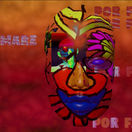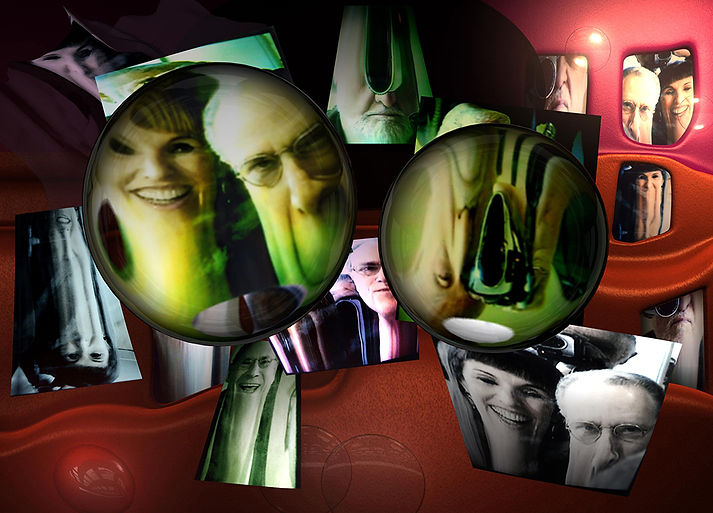experimental & video portraits

REMIXING THE MIX

Remixing the Mix, 2021
Ellen Sandor & (art)n: Diana Torres and Azadeh Gholizadeh
Based on No Fumare, por Favore, 1997 done in collaboration with Ed Paschke
Video Portrait
The Other Window: Distortion ‘06
This project began with a shared love for the work of André Kertész, who was profoundly attuned to everyday life, which he penetrated beyond, in varied and commanding bodies of work. I became very excited when I heard that Stephen Daiter Gallery was exhibiting one of the original funhouse mirrors that Kértesz used in his Distortion series, in an exhibit of Kertész's works at the gallery in March 2005. The Distortions (1933), are one of Kertész's most alluring and confounding bodies of work. I was very familiar with the Distortions, but the first time I had the opportunity to study them first hand was at the Richard and Ellen Sandor collection.
More than 30 years ago Richard, Ellen, and I began to exchange our thoughts and feelings about historic photography, contemporary photography, and photography on the cutting edge from both realms. As a student of photography and sculpture, Ellen ended up taking photography into the future with the remarkable invention and subsequent development of the PHSCologram. As a scientist, economist, and collector, Richard has always had an eye for the unusual potential in the commonplace, which undoubtedly informed his sensitivity to Kertész's work, and the subsequent collection of many of his photographs. Kertész's talent for seeing the unexpected in ordinary things is something many other photographers have missed. Because of this shared sensibility, the Kertész photos and the unique visual moments they capture were immediately exciting to all of us.
With Kertész.'s funhouse mirror in Chicago, Ellen, Richard, and I spent an afternoon making group portraits together, interacting with Kertész's distorted, reflective, historic object. We created a series of photos through the transfer of High Definition Digital video to chromogenic prints. The obvious conclusion for this project was to consummate the process in a PHSCologram image.
The (art)n collaborative group for the PHSCologram The Other Window: Distortion .06 represents three generations of SAIC graduates. With thanks to Ellen and Richard Sandor, (art)n and Stephen Daiter Gallery.

The Other Window: Distortion ‘06
James Zanzi
Ellen Sandor & (art)n
Special thanks to Janine Fron and Lisa Stone
Virtual Photograph/PHSCologram: Duratrans, Kodalth, Plexiglas
30 x 30 inches
The Other Window: Distortion ‘06
James Zanzi
Ellen Sandor & (art)n
Special thanks to Janine Fron and Lisa Stone
Virtual Photograph/PHSCologram: Duratrans, Kodalth, Plexiglas
30 x 30 inches
The Other Window: Distortion ‘07
Inspired by The Other Window: Distortion '06, this piece creates a distorted fun house view of three generations of artists in homage to André Kertész that celebrates the process and history of photography as an art form, featuring portraits of Ellen and Richard Sandor with Jim Zanzi.

The Other Window: Distortion ‘07
James Zanzi
Ellen Sandor & (art)n: Chris Kemp and Thomas Meeker
Special thanks to Janine Fron and Lisa Stone
Virtual Photograph/PHSCologram: Duratrans, Kodalth, Plexiglas
40 x 30 inches
lover's leap, view up | view down


Lover's Leap, View Up | View Down, 1994–1995
Ellen Sandor & (art)n: Stephan Meyers and Janine Fron
Miroslaw Rogala and Ford Oxaal
Virtual Photograph/PHSCologram: Cibachrome, Kodalth, Plexiglas
14 x 11 inches
Video detail from the real-time interactive multimedia installation "Lovers Leap."
Collection of Seimens. Featured in "Photography After Photography” Traveling Exhibition and Catalog., December 1994-January 1997.
The first video portrait, featuring Mark Resch (left) and Ellen Sandor (right), produced with an early morphing technique.
(don't bother me while I'm talking), 1986
Ellen Sandor & (art)n: Mark Resch
Dan Sandin, Electronic Visualization Lab, School of Art and Design, University of Illinois at Chicago
Virtual Photograph/PHSCologram: Kodalith, Kodalth, Plexiglas
14 x 11 inches
(don't bother me while I'm talking)
The first video portrait, featuring Mark Resch (left) and Ellen Sandor (right), produced with an early morphing technique.
(don't bother me while I'm talking), 1986
Ellen Sandor & (art)n: Mark Resch
Dan Sandin, Electronic Visualization Lab, School of Art and Design, University of Illinois at Chicago
Virtual Photograph/PHSCologram: Kodalith, Kodalth, Plexiglas
14 x 11 inches

Image Processed Video Portrait of Ellen Sandor
Image Processed Video Portrait of Ellen Sandor, 1986
Ellen Sandor & (art)n
Dan Sandin, Electronic Visualization Lab, School of Art and Design, University of Illinois at Chicago
Vintage video PHSCologram: analogue interleaved Kodak Fast Film and Kodalith films mounted on plexiglas
14 x 11 inches
Sandor Set/Economic Chaos
A video portrait of Richard Sandor juxtaposed with a computer generated Fiegenbaum Bifurcation diagram.
Sandor Set/Economic Chaos, 1986
Ellen Sandor & (art)n: Mark Resch and Stephan Meyers
Dan Sandin, Electronic Visualization Lab, School of Art and Design, University of Illinois at Chicago
Virtual Photograph/PHSCologram: analogue interleaved Kodak Fast Film and Kodalith films mounted on plexiglas
14 x 11 inches
Image Processed Video Portrait of Dan Sandin
I participated in my first interactive computer environment in 1969, an exhibit developed with Dan Sandin (who later invented the video-image processor and, in 1976, the data input glove), sculptor Jerry Erdman, and computer science professor, Richard Venezsky. This exhibit, called "Glowflow" was controlled by traditional artistic sensibilities. Basically, it was a sculpture, a computer-controlled, light-and-sound environment. On the walls of a room there were tubes filled with colored phosphorescent pigments suspended in water. The room was otherwise dark, so the glowing tubes defined the space. For instance, the bottom tube represented the floor. As people walked into the room, they saw the tube slanting slightly downward, so they would lean backwards-they thought they were going downhill. It showed the incredibly powerful role that our visual sense plays in defining reality.
Glowflow also incorporated six loud-speakers and spatial sound imaging. Sounds rotated around the room or "bounced" from wall to wall. Controlled by a Digital Equipment Corporation PDP-12 minicomputer, the system ran lights, loudspeakers, and a Moog sound synthesizer.
Dr. Myron W. Krueger, Ph.D., "The Art in Artificial Reality-Videoplace & Other New Forms of Human Experience," 1992, Linda Jacobson, CyberArts-Exploring Art & Technology
Image Processed Video Portrait of Dan Sandin, 1986
Ellen Sandor & (art)n
Dan Sandin, Electronic Visualization Lab, School of Art and Design, University of Illinois at Chicago
Vintage video PHSCologram: analogue interleaved Kodak Fast Film and Kodalith films mounted on plexiglas
14 x 11 inches
First Video Portraits
The first video portraits produced with an early morphing technique.


Julie (left), Ellen (Right), 1986
Ellen Sandor & (art)n: Mark Resch
Dan Sandin, Electronic Visualization Lab, School of Art and Design, University of Illinois at Chicago
Virtual Photograph/PHSCologram: Kodalith, Kodalth, Plexiglas
14 x 11 inches


Penny (left), Penny, Julie and Mom (Right), 1986
Ellen Sandor & (art)n: Mark Resch
Dan Sandin, Electronic Visualization Lab, School of Art and Design, University of Illinois at Chicago
Virtual Photograph/PHSCologram: Kodalith, Kodalth, Plexiglas
14 x 11 inches
Video fashion portraits

Video Fashion Portraits, 1987
Ellen Sandor & (art)n: Mark Resch, Gina Uhlmann, and Randy Johnson
Professor Jim Zanzi, The School of the Art Institute, Chicago
Dan Sandin, Electronic Visualization Lab, School of Art and Design, University of Illinois at Chicago
Vintage video PHSColograms: analogue interleaved Kodak Fast Film and Kodalith films mounted on plexiglas
(3) 14 x 11 inches
Color Nude Study

Color Nude Study, 1987
Ellen Sandor & (art)n: Jim Zanzi, Mark Resch and Gina UhlmannDan Sandin, Electronic Visualization Lab, School of Art and Design, University of Illinois at Chicago
Virtual Photograph/PHSCologram: Kodalith, Kodalth, Plexiglas
(3) 14 x 11 inches


















